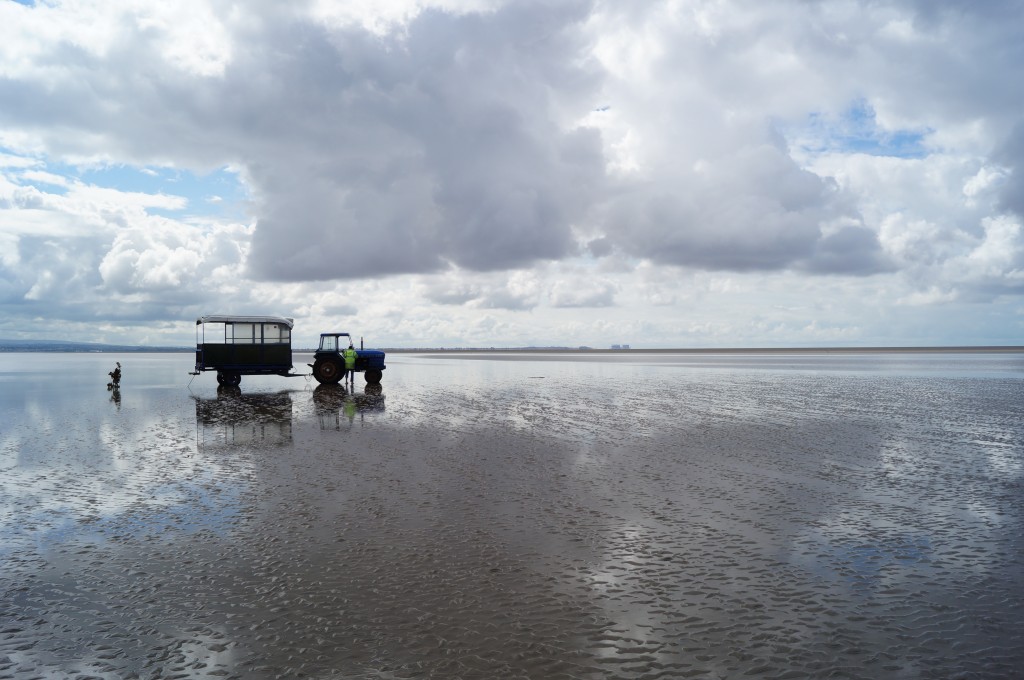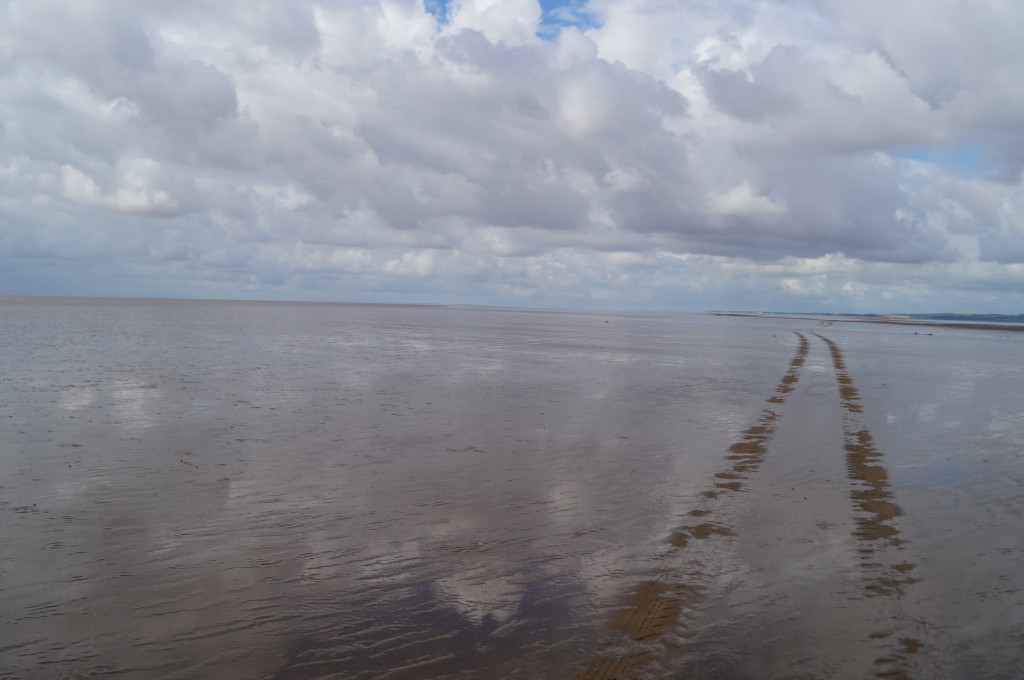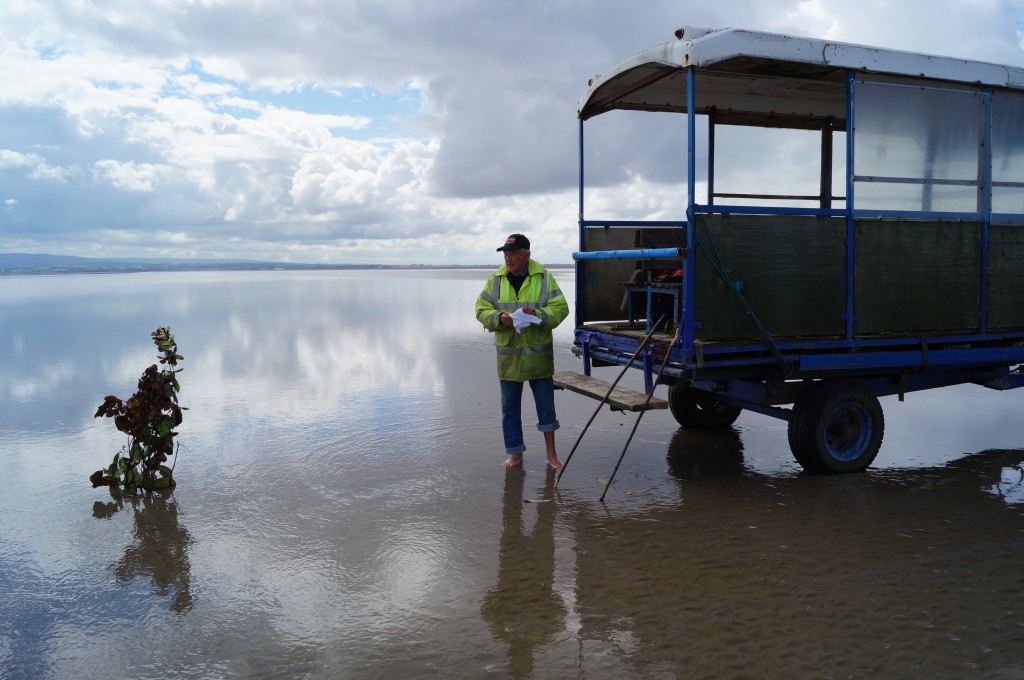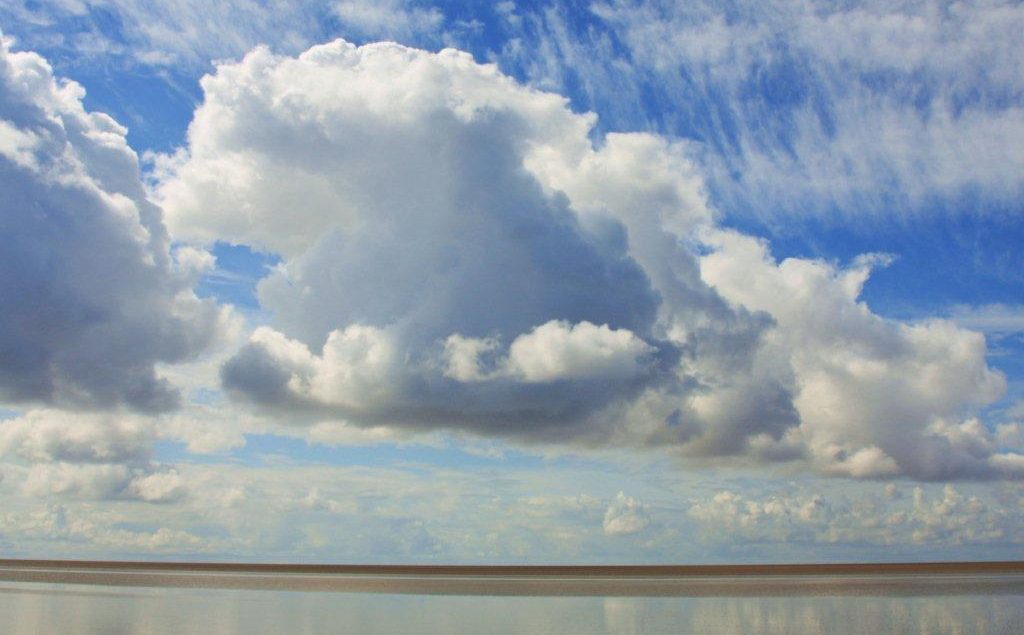Karen Lloyd – Testing the Sands
Last year The Clearing visited Morecambe Bay in a provoking and memorable essay by Paul Kingsnorth. We are very pleased this week to be returning with a fresh pair of eyes. Karen Lloyd has lived for most of her life near the bay and in what follows she visits this strange and challenging landscape with Cedric Robinson, the ‘Queen’s Guide to the Sands’.
On that day, after weeks of mild weather and hardly any rain, the Kent looked nothing like a river. How different its character from the clear, voluble stretches that tumbled and splashed down from the Kentmere hills, passing through the valley and woods close to our house in Kendal. It was the same element but there the comparison stopped. The river was wide and glossy, more a shallow, sky-reflecting lake than a flowing body of water as it arced towards the south on a lazy journey, passing Silverdale, Carnforth and Morecambe. The tractor pulled up at the rivers’ edge and we climbed down, then rolled our trouser legs high. Barry handed us each a sturdy wooden stick and each of us carried a bundle of brobs, hoisting them onto our shoulders. I left my brand new camera in the trailer. Andy was made of sterner stuff and took his along.
The men analysed the condition of the river, and from their talk it was as if it was a living being to them.
‘A wind from the north-west like today pushes the river slow and wide,’ Cedric said, ‘but a big wind and heavy rain makes it cut a direct path, and it’ll move at speed – much deeper too.’
I’ve spent significant periods of time walking alone in the mountains. I’ve been lost and disorientated in mists, but this was something new, this sense of flat space where distances are difficult. We were about four miles out on the bay, halfway between Humphrey Head and White Creek at Arnside. I wasn’t alone and of course I couldn’t have been in safer hands, but there was something about this landscape and our remoteness from land that made me uneasy; it was a new sensation for me. Cedric climbed back in the tractor, shouting as he did.
‘I don’t like this bloody tractor one bit. I don’t trust it either,’ and he headed away, leaving the three of us behind in the middle of that expanse of sand.

I’d planned an early morning rendezvous with Cedric Robinson, the nation’s only ‘Queen’s Guide to the Sands.’ We’d talked on the phone the evening before, and I found him still giddy, fizzing even, from having lunch with the Queen and Princess Anne on their official visit to South Cumbria that day.
‘We were asked to go into the dining room and find our place names. Well, I found two! One next to Princess Anne, and the other next to the Queen! So I went to find a steward and I told him and do you know what he said? He said “well, Cedric, it looks as if you will just have to choose for yourself who you sit next to.”
‘So,’ Cedric said, ‘I chose Princess Anne. And she was absolutely lovely, and do you know she was a very good conversationalist.’ I told him he’s a great one for hob-knobbing with royalty.
Cedric’s status in the Morecambe Bay area is legendary. His knowledge of the tides and the rivers that shift their route through the sands sometimes by a mile or more in one night is unsurpassed. He’s the fifty-fifth Guide to the Sands and has been in the job for fifty years. At eighty, he has the physique of a man half his age; he’s tall, tanned, (or weathered), big- chested and upright, a man in his element and comfortable in his own skin.
Cedric was going out to test the sands and the state of the river Kent ahead of two crossings later that week, one for a group of horse and carriage enthusiasts and then a weekend cross-bay walk. Any crossing depends on the weather, but more than that on the amount of rain that’s fallen on higher ground. In a bad summer like the previous four or five, more walks are cancelled than take place.
We planned to meet at Humphrey Head, a whale-backed, limestone outcrop projecting into the bay from the low lying fields of the Cartmel peninsula. Here, local legend would have you believe, the last wolf in England was pursued and killed.

Early the next morning I drove over from Kendal and into the small lanes that lead to the headland. Rounding a bend a young leveret was sitting mid-road, warming itself up in the sun. It moved off distractedly, lolloping ahead with black-tipped, pale-edged ears like vertical radar, switching direction continuously. Articulating its powerful hind legs, slowly it began to jig from side to side like a wind-up toy, all eyes, ears and legs and then disappeared under the shelter of a hawthorn hedge.
In the small car park under the cliff face the quality of silence was immediate; a rare moment. The engine ticked as it cooled and a wren chit-chitted in amongst young hazel and hawthorn on the cliff face, otherwise all was utterly still. Poking above the marsh grass to the south west, the turbines of Walney Wind Farm were illuminated by the low sun, glimmering like a row of distant candles. Standing beside Humphrey Head there’s an illusion that the surface of the bay slopes upwards, rising higher than the land around it. It’s a trick of the light and the land and the vast, flat distances. A woodpecker called from the scrub close by. I could see Hoad Monument, the hilltop lighthouse folly at Ulverston, standing out from the shadowed hills behind it. I’d learned the word ‘glas’ from the Welsh poet, Gillian Clarke, a potent word for the particular blue-green of hills. There it was, defining the white monument, the glas of Kirby Moor.
Forty five minutes after our agreed meeting time, a spindly, aged tractor bounced into view with Cedric at the driver’s seat, pulling an eccentric-looking jalopy, part child-catchers wagon from Chitty Chitty Bang Bang and part ancient farm wagon. It was all patched ply-wood and weather-blasted Perspex.
‘Sorry we’re late’ Cedric said ‘I had to borrow a tractor. Mine’s gone in for a service.’
I told him not to worry, and climbed up into the trailer where his two assistants, Andy and Barry sat on a row of back-to-back benches. The floor was strewn with laurel branches. We set off. Within seconds, Cedric stopped and was down on the ground checking the best route across a deep gully, and then the same a second time. With a large shovel he dug out a smoother path, but we still held on tight as the tractor and trailer plunged into and out of each one, bucking and bouncing, before the tractor reached smoother ground.
I looked up above the cliffs of Humphrey Head and saw there, swivelling on the air, a peregrine. It folded its wings, dropped a distance, then rose up again on the morning thermals.
‘They’re doing well here,’ Barry said. ‘The young have fledged; we saw them a few weeks back.’
Travelling out onto the bay there was a new sightline of the headland. The rocks rose out of the sand, then continued upwards in folded waves of limestone. With a row of fence posts like tiny spines along the ridge it reminded me of a sea creature emerging out of, or plunging underneath the bay.
The tide had been out for hours but a layer of water remained like a second skin over the sands and in places there were deeper pockets and shallow lakes of standing water. The trailer rode into and out of channels like a ship ploughing the ocean. In the lee of the headland, a solitary egret stood white and motionless, like marble. Further out the surface of the sands changed and became smoother. We made a wide curving entrance to the bay.
Another shift in terrain and the trailer began to bounce up and down. We held on to the seats again, passing small cliff edges that had formed and collapsed again as big waves had washed against them. After that an area where the sands had formed into mounds, like the glacial moraine of a retreating glacier.
‘I call this the Somme’ Barry said, ‘These mounds come from the weight of the tide passing over areas of softer or more compressed sand.’
I saw cockles heaped up within the mounds, their edges semi-exposed like treasure.
‘The past few cold winters have finished them off. They’re mostly dead, no good to anyone’ he’d said. The beds had been closed since the cockling disaster in 2004; the echoes keep travelling.
The surface changed again and we moved on over a skin of perfectly becalmed water that reflected the sky, so that as I looked down we drove over intense cobalt-blue and cumulus cloud streets. The tyre marks fractured the surface, distances elided and light spooled on the sinuous ground like heavy white blossom. I remarked on the way the surface changes from one area to the next and Andy said ‘It does, all the time; every day sometimes. Over at Arnside the sands are as smooth as glass-paper just now.’
The guides have used laurel branches for centuries for marking the safe crossing routes over the sands. Their thick leaves stay on the branches even when submerged daily by the tide. They’re known as ‘brobs’. They’re there in the paintings of the bay that Turner made. We drove past brobs that had been put in position on previous visits. From a distance they resembled people who had somehow been left behind, lone figures adrift on the empty bay.
‘That one; the one all on its own’ Barry said. ‘We call it the “man brob”’, as if he’d read my mind.

The three of us were standing at the edge of the river in the middle of the bay. Further downstream where Cedric had stopped the tractor, I watched as he wandered, looking, stopping, and setting new brobs. I began to wonder what time the tide was due in and how long we would be out there.
A helicopter droned in from the east and swung in closer to have a look at us. Resisting the temptation to wave I wondered what the people inside thought of us, standing at the edge of a river in the middle of the bay, miles away from land.
Barry and I paddled into the river. Andy was already mid way across and taking photographs. The waters changed gradually from shallow and clear to grainy, textured water that came above our knees. I stopped to hoist my trousers higher, then taking slow steps in the cloudy water, I let out a cry of surprise.
‘What’s up?’ Barry asked.
‘A fluke!’ I said, ‘I stood on a fluke.’
The squirming sensation had caught me unawares. The fluke was the flounder commonly found in Morecambe Bay.
‘Last time that happened I was about eight years old. My pal’s dad took us out to tread for them, but I remember I didn’t fancy the idea of standing on any.’ The traditional way of catching flounder is to feel for them with the feet, then reach in and under the water to pick out the fish before it had a chance to wriggle away.
A moment later there was the distinctive bounce of a fish on my leg. I wondered what, if anything, the fish thought about it.
Twice in the crossing Barry stopped to test the flow-rate with his low tech device. He simply watched the speed of the water pushing past his stick. We waded further and after some minutes came to the other side, throwing the brobs down in a heap. Andy arrived alongside us, and working together the two of them began setting the brobs into place. Andy pushed and wound his stick far down into the mud.
‘Are you ready?’ he said, then pulled out the stick as Barry pushed a brob down into the loosened sand, securing it as the mud and water closed the hole again.
Over our heads a small group of young gulls had come winging. They flew as if intoxicated, directionless, mob-handed, adolescent, their cries argumentative against the complete silence of the bay. They flittered down onto the sands and joined a long line of birds that had settled in to feed on the surface a distance away. Looking through the binoculars I saw that there were hundreds, maybe thousands of oystercatchers. I’d never seen so many in one place before.
I’d visited Cedric at home on a freezing February afternoon, and sitting in front of the banked up fire, my cheeks growing hotter by the minute, he’d told me his name for oystercatchers.
‘I call them “sea-pie”. They’re wonderful birds. I’ve watched them riding the bow wave when the bore comes in. Fifty years ago the bore was a very different kind of a beast. You could hear it coming a mile off, with a three foot standing wave at the front and sea-pie skimming the top of it. What a sight that was.’
Stitched in amongst the oystercatchers were countless gulls. Out there on the bay, it was the undisputed kingdom of birds.
Cedric drove back towards us. He climbed down and left the engine sputtering. ‘It’s changed its course again; do you think?’ he called across the river. Barry and Andy shouted agreement. ‘Significantly. Moved about half a mile I think.’
‘What’s that sticking out of the water? Is it a bird?’ Cedric asked.
‘I’ll go and have a look’ Andy said, and began walking downriver towards a dark object at the river’s edge. It didn’t fly away.
‘It’s a brob alright’ he shouted back to us. He pulled it out and re-set it on the river-bank.
‘We set them in pairs’ Barry said as we watched. ‘They’re like channel markers for shipping, so it’s clear where to cross the river.’
A dark rain cloud came close, pushed along by the westerly wind. We wondered if it would release its load onto us as we felt the first large splots of rain. But it skimmed past and headed Morecambe way. As it moved it grew darker and moments later bands of heavy rain fell from it. I could imagine tourists on the imported sand beaches at Morecambe stuffing towels into bags and rushing off to the cafés until it passed.
Cedric came wading back across the river towards us, and singing at the top of his voice. If Cedric formed a religion, I might be tempted to follow.
With the four of us together again, Cedric marked the time and the men made calculations about the tide times for the coming days. It’s crucial, of course, to get it right. That’s part of the reason the men were there; not just to test the riverbed for quicksand and mark safe crossings away from it, but also to mark the time and to know when to be back on dry land again. It was eleven thirty. In another four hours the place we stood would be submerged beneath ten metres of water.

Barry’s a blow-in of eleven years from Manchester. He wanted to know the names of the mountains that framed the view at the back of the bay. I named them for him.
‘That’s Fairfield, Red Screes, then the gap of Kirkstone Pass, then Caudale Moor and the hills of Kentmere; Froswick, Ill Bell and Yolk.’ Cedric overheard and said: ‘I’ve never heard of any of them.’ I wondered if he was having a joke. But maybe not, after all the bay is his territory; he’s on intimate terms with one hundred and twenty square miles of tidal estuary. I said ‘I like the fact that you can see the source of this river, the mountains of Kentmere, just there.’
Cedric pointed to a wide bend in the river a distance away. ‘See the way light sparkles on that stretch of water? That shows the river’s moving much faster down there.’ And I did, but a question formed itself, of how Cedric’s knowledge can be kept going into the future. You can’t archive this stuff, nor create a websites for it. You can’t communicate about this place by email; it has to be experienced.
Andy and Barry continued setting brobs. Cedric and I began to wade back across the river towards the idling tractor and we talked about the continuation of the over-sands route that crosses between Flookburgh and Ulverston. It involves the crossing of two more rivers, the Leven and the Crake. We’d stopped to talk mid river, and as we talked I found that my unease and that sense of unfamiliarity had all evaporated, moved away like the dark cloud, and all the while the river pushed on, pressing gently against our legs.
Oystercatchers slung past us in arrowhead formation. Nodding in their direction of travel Cedric said, ‘We’ll head over to that bank for our coffee.’ From a high vantage point and with the tide out the bay may appear to be one continuous stretch of sand. I couldn’t see a bank, but I knew that the bay was anything but flat. More pictures came to me from the winters’ afternoon by Cedric’s fire.
‘There are banks and gullies out there; great holes big enough to swallow a tractor, a double-decker bus even. We’d go night fishing, with tractors, depending on the state of the tides, fishing for shrimps. One night we were driving along in the moonlight and all of a sudden matey on my right disappeared, tractor and all. He’d gone straight into a massive gully. A ‘melgrave’ we call these big holes. Anyway, he managed to climb out alright but the tractor was another story. We never saw it again.’
He described too how, after yet another episode of unnervingly heavy rains that we’ve had over these past few years, he’d gone out to assess the state of the river. He said he’d been left almost without speech, and that’s something.
‘The river had cut a new channel overnight, six miles away from its previous course.’ He described the river that day as being ‘like a roaring sea.’
The tang of coffee filled the trailer and Cedric held court, telling us tale after tale. His is a rich, deep seam of powerful memories, and he offered them up with generosity, for our entertainment and I thought, for himself, for the vigour of remembering.
‘I’d gone out shrimping at night with our Jean. She was about twelve then I think. It was as clear as a bell when we set off; the stars were all out, and the moon, and you could see the lights of all the villages around the bay. It was a good night for navigation. We were miles out, and busy with the fishing, then when we came to go home I looked up and the fog had rolled in. We couldn’t see a thing. Well that night I navigated home by listening for the sound of the river. That did the trick. Anyway, we lived to tell the tale.’
Immense cumulus clouds streets had continued to form around the edge of the Bay. They built height over the land, leaving the sky above the bay a clear and potent blue. I’ve seen this so often, the sky clearing, as if putting itself in order ready for the approach of the tide. As we set off for Humphrey Head again, the headland appeared like a wave swelling out of the sands, and in the distance Peel Castle shimmered above translucent air. In the heat haze the hills of Furness were breaking up into segments that moved and danced.
On the journey back to land we passed close to the Man Brob, and as we drove past Barry said ‘A few weeks ago we came out and I could see something odd about the shape of it. As we got closer whatever it was took off. It was a peregrine. He’d been sitting there in splendid isolation until we came along.’
We were back, rolling over the saltmarsh and bumping into and out of the two gullies. Underneath the limestone cliffs, I climbed down. We said our farewells and the tractor disappeared up the lane. I listened as the hum of its engine faded off into the countryside until all was quiet again. I had a sense that those hours out on the bay would stay with me for a long time, glimmering like the river as it moved by degrees further and further into the distance.
Karen Lloyd lives in Kendal, Cumbria, and has lived for most of her life within a stone’s throw of Morecambe Bay. In November she was awarded a Distinction for her MLitt at Stirling University where her tutor was Kathleen Jamie, and is working on a book, The Gathering Tide, about a journey around the edgelands of the bay.
With special thanks to Cendric Robinson, Andy Mortimer and Barry Kieran.

3 Comments
Join the discussion and tell us your opinion.
Hello Karen
My dear chum Andy Mortimer sent me this link to your essay about your day out in the bay with Cedric. Congratulations. It is a superb piece of writing, capturing the atmosphere of all that the bay is and can be, and it is rivetting to read. And we pick up hints and rumours of who this woman Karen Lloyd might be, with her passions and knowledge. Lovely photographs too. Thank you.
Warmest wishes Sue Gill.
What a great read – really original.
Thank you Don.